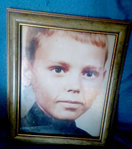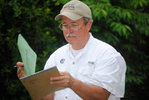

“It was Nov. 1, 1972. I still remember that day. I stood outside at the road at night and looked for him, but he never came back,” said Alberta Fillers as she softly cried. “He might have been gone for a while, but it still hurts.”
Forty-eight years ago, she dropped off her son, 14-year-old William Edward Huff, at the junior high school. He never came home.
Billy’s body, along with that of a friend James Allen Crosby, was found 12 years later in the woods behind the airport.
But Fillers still waits, hopes. “I just want to find out who did it and why. I just want to know what happened to my son,” she said.
And no one knows.
“He was a good boy. I didn’t know the other boy too good, but I know they were good friends at school and he didn’t show up at school that day. I went to get him and he wasn’t where he was supposed to be. I went in the school house, and they weren’t there. Then I got somebody to call the sheriff’s office.”
Twelve years later in April 1984, two men were running a dog in the woods behind the airport when they found a boot and pair of pants and some bones.
“I remember the day they found his remains,” Fillers said. “They took me up there and I saw those shoes. Those were his shoes.”
“It was 1972. We still don’t have closure,” said Billy’s sister Charlene Huff, who was eight when he disappeared. “We’d really like to get closure, see what happened to him — who did it if they’re still alive.”
A man identified as a Walterboro businessman came forth in 1987 and said in the fall of 1974, he and three other teenagers found the bodies while cutting school, but were too afraid to tell anyone. “He could have come forth back then and they may have been able to find their bodies then, not years later,” Charlene said. “Not just letting the family wonder if they were alive or dead.”
Alberta Huff Fillers is 83 now, has suffered the loss of her husband, her four sons and one daughter. And the loss of Billy still haunts her.
“I think there’s someone out there who knows what happened, but they’re not going to tell. I just want someone out there to come forward and tell the truth so I can lay my son to rest,” Fillers said.
(Editor’s note: The mother of the other missing boy, James Allen Crosby, declined to be interviewed for this story.)
The history
On November 1, 1972, 16-year-old James Allen Crosby and 14-year-old William Edward Huff were dropped off by their mothers at Colleton Junior High School. The best friends were never seen again.
Short stories ran in The Press and Standard later that month, saying the boys were missing and asking anyone with information to call then-Sheriff John I. Seigler. No one came forward. Searches — on foot by deputies and Rescue Squad volunteers and in the air by a SLED plane — proved futile.
The investigator
In May 1984, Colleton County Sheriff’s Deputy Steve Bazzle headed the investigation into the remains of two skeletons found behind the airport, after two men hunting for game trails found a boot, some clothes and a few bones.
The remains were identified as James Allen Crosby and William Edward Huff, who disappeared from the junior high school on November 1, 1972.
Bazzle worked on the case for two years, but it remains one of the unsolved cases he still wonders about in his years as a deputy. “We just had a few items of clothing, a few bones and no skulls,” he remembered. “The way I got started with it, I talked with the guy who was the coroner, Bob Bryan. He remembered the missing boys because at the time in 1972, he was deputy coroner when Sheriff Siegler followed up on a skull that was found at Ireland Creek around this time,” Bazzle said. The skull was never linked to the two boys.
1972 was a different time. The Sheriff’s Office had about six officers, the police department fewer. Fire departments were all volunteer. There were no ambulances or medics — the two funeral homes transported the injured to hospitals. There was a volunteer rescue squad. All searched for the boys, but found nothing.
After the missing boys’ remains were found in 1984, Bazzle was one of only 12 sheriff’s deputies and he tried to find out what happened to them. But after 12 years, any evidence was gone. “There was no beltline back then. There was a county landfill behind the school and then the runways. So there was nothing back there except paths and old airbase taxi runways. There were no roads,” he said. The land off the paths were covered with “mostly plum trees. Those things grow so thick and they’ve got thorns all over them. There were certain areas you could go through, but we had a hard time just getting back there to work the scene,” he remembered. “There was just nothing to work with after that period of time,” Bazzle said.
“Recently there was a question about DNA, but there was nothing that DNA could have been compared to when it became an accepted test, because we knew who they were — and there was nothing recovered that would have been considered to belong to a suspect to even compare DNA to.
“People often questioned the absence of the skulls. When you’ve skeletal remains that’ve been in the woods for 12 years, animals play a huge part,” he said. And then there was a question about why the clothes were in such good shape. But Bazzle said, “You’ve got to remember that this was in the 70s — everything in the 70s was polyester. Polyester doesn’t rot. That stuff stays around forever.”
In short, he had no evidence to work with to close the case. Now, 48 years later, he doesn’t have much hope the case will ever be closed. No new information at all has ever surfaced in 48 years. “You’re talking such a time period — short of some deathbed confession of somebody wanting to clear their conscious before they go to the Lord — I can’t imagine somebody popping up and saying ‘Yeah, I know about it’ if it hasn’t happened by now.” He thinks the boys were just in the right place at the wrong time. “Why it became the wrong time, I just don’t know.”
But that doesn’t keep Bazzle from wanting closure too. “I still have cases I think about and wonder about. Most of my years have been as an investigator, homicides and such. So yeah, I’ve got a bunch of cases I still think about. “And there’s nobody, except the family, that wants this closed more than I do.”